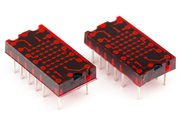
Difference: RaspiElfDisplay (4 vs. 5)
Revision 52018-05-07 - PeterSchmid
| Line: 1 to 1 | ||||||||
|---|---|---|---|---|---|---|---|---|
%DASHBOARD{ section="banner" | ||||||||
| Line: 7 to 7 | ||||||||
| titlestyle="color:#F00000;"
}%
Intro
| ||||||||
| Changed: | ||||||||
| < < | Long time ago I built a LED display and a hex keypad for my COSMICOS. I lend the COSMICOS and the extensions to a friend's brother and I saw the parts never again. Thanks to Lee Hart's 1802 Membership Card | |||||||
| > > | Long time ago I built a LED display and a hex keypad for my COSMICOS. I lend the COSMICOS and the extensions to a friend's brother and I saw the parts never again. Thanks to Lee Hart's 1802 Membership Card | |||||||
|
| ||||||||
| Changed: | ||||||||
| < < | TIL311 hexadecimal displays were to expensive for me 35 years ago and now they are not easy to get (and still expensive). The 4×7 rounded font looks far better than the seven-segment display especially the lower case hex display letters. But there is an alternative: LTP-305 from LITEON. They have no integrated driver, but the matrix LED driver IC IS31FL3730 | |||||||
| > > | TIL311 hexadecimal displays were to expensive for me 35 years ago and now they are not easy to get (and still expensive). The 4×7 rounded font looks far better than the seven-segment display especially the lower case hex display letters. But there is an alternative: LTP-305 from LITEON. They have no integrated driver, but the matrix LED driver IC IS31FL3730 | |||||||
| | | | ||||||||
| Line: 30 to 30 | ||||||||
|
I still want to use the 1802 Membership Card's | ||||||||
| Changed: | ||||||||
| < < | Python Library and Examples for Micro Dot pHAT on GitHub | |||||||
| > > | There is Python Library and Examples for Micro Dot pHAT on GitHub | |||||||
| Added: | ||||||||
| > > | Check for the I2C device: | |||||||
pi@cosmac:~/elf $ ls /dev/*i2c* /dev/i2c-1 | ||||||||
| Changed: | ||||||||
| < < | Check for the I2C devices. | |||||||
| > > | Detect the I2C chips: | |||||||
pi@cosmac:~/elf $ i2cdetect -y 1
0 1 2 3 4 5 6 7 8 9 a b c d e f
| ||||||||
| Line: 50 to 51 | ||||||||
| 60: -- 61 62 63 -- -- -- -- -- -- -- -- -- -- -- -- 70: -- -- -- -- -- -- -- -- | ||||||||
| Added: | ||||||||
| > > | 61, 62, and 63 are the I2C addresses of the IS31FL3730 chips. | |||||||
|
| ||||||||
| Line: 90 to 92 | ||||||||
| ||||||||
| Changed: | ||||||||
| < < | For 6 digits we need 36 GPIOs. Without blanking 32 GPIOs, shared latch 25 GPIOs. The Raspberry Pi has 26 GPIOs (we can have a latch for the data and a latch for the address). | |||||||
| > > | For 6 digits we need 36 GPIOs. Without blanking 32 GPIOs, and shared latch input 25 GPIOs. The Raspberry Pi has 26 GPIOs, the spare GPIO ca be used for an additional latch input, then we have a latch for the data and a latch for the address. | |||||||
| Changed: | ||||||||
| < < | The Spare Time Gizmo's Elf 2000 | |||||||
| > > | Usually the CDP1802 computers use a multiplexed address bus e.g. the Spare Time Gizmo's Elf 2000 | |||||||
| ||||||||
| Changed: | ||||||||
| < < | Only 18 GPIOs needed. Do not forget: the Raspberry Pi GPIOs are not 5 V compatible. | |||||||
| > > | This is a total of 18 GPIOs. Do not forget: the Raspberry Pi GPIOs are not 5 V compatible! | |||||||
| Added: | ||||||||
| > > | Is somebody out there interested in a TIL311 emulator? Linux is not a Real Time Operating System (RTOS), and it is easy to miss a strobe signal, even if we use interrupts. | |||||||
View topic | History: r13 < r12 < r11 < r10 | More topic actions...
Ideas, requests, problems regarding TWiki? Send feedback

